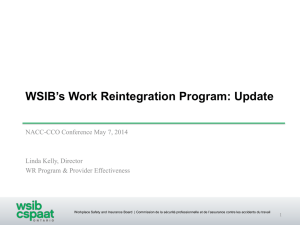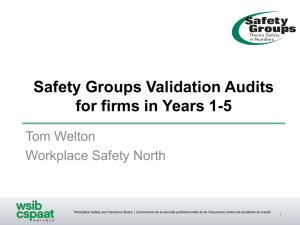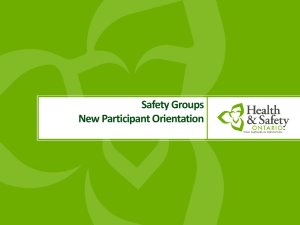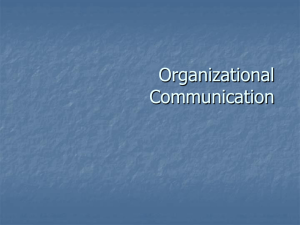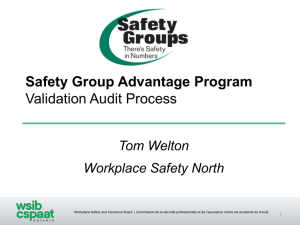PowerPoint
advertisement
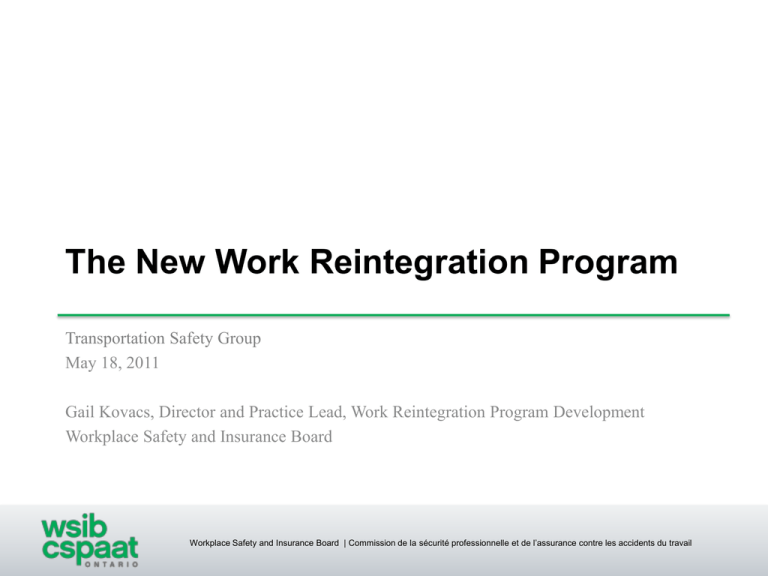
The New Work Reintegration Program Transportation Safety Group May 18, 2011 Gail Kovacs, Director and Practice Lead, Work Reintegration Program Development Workplace Safety and Insurance Board Workplace Safety and Insurance Board | Commission de la sécurité professionnelle et de l’assurance contre les accidents du travail The Legislative Mandate of the WSIB ■ The WSIB operates within a defined legislative mandate. That mandate is comprised of four key elements, which can be summarised as follows: – To promote health and safety in workplaces – To facilitate the return to work and recovery of workers – To facilitate the re-entry into the labour force of workers and spouses of deceased workers – To provide compensation and other benefits ■ The existence of this legislative mandate sets clear parameters in which the WSIB must operate Workplace Safety and Insurance Board | Commission de la sécurité professionnelle et de l’assurance contre les accidents du travail 2 Case for Change ■ Duration had increased at every window ■ The number and level of locked-in LOE awards had been rising ■ The WSIB’s Return to Work (RTW) and Labour Market Re-entry (LMR) programs had limited success with overall poor employment outcomes for injured workers ■ Injured workers concerned about “retraining for jobs that don’t exist” ■ Employers concerned about escalating costs ■ Too many injured workers not being re-employed with injury employer and the cost of LMR was transferred to the Unfunded Liability (UFL): - 77% of workers in LMR had re-employment rights but did not RTW with the injury employer - 48% of LMR cases have SIEF relief, at an average of 66% - most workers enter LMR just before or after the ER window closes Workplace Safety and Insurance Board | Commission de la sécurité professionnelle et de l’assurance contre les accidents du travail 3 Value for Money Audit Recommendations 1. Integrated Work Re-integration Model 2. Employer Accountability 3. Cost Management 4. Service Quality 5. Worker Input and Choice 6. Complaint Management Workplace Safety and Insurance Board | Commission de la sécurité professionnelle et de l’assurance contre les accidents du travail 4 Leading Practices in WR ■ Focus on “ability” rather than “disability” ■ Employer accountability for work reintegration ■ Worker centric work reintegration principles and approaches ■ Worker self-determination ■ Incentive programs for employers to retain or hire injured workers ■ Benefit schemes that remove long-term benefit dependency ■ Enhanced case management approach ■ Professionalization of staff responsible for work reintegration service to injured workers Workplace Safety and Insurance Board | Commission de la sécurité professionnelle et de l’assurance contre les accidents du travail 5 Work Reintegration (WR) Model ■ The Vision – Reintegration into decent, safe , and sustainable employment, maintaining the dignity of the worker ■ The Goal - Employment. ■ The Principles 1. Maintain the employment relationship, wherever possible, between the worker and the injury employer, all parties have a shared obligation. 2. Provide effective and meaningful input and choice on the part of the worker, 3. Maintain high standards for services provided by WSIB staff, contracted parties, to ensure effective, quality services that achieve desired employment outcomes. 4. Manage the costs of the program but do not be managed by the cost. 5. Ensure workers are fairly compensated for wage loss, recognizing the difference between pre-injury earnings and post-injury earning ability. Workplace Safety and Insurance Board | Commission de la sécurité professionnelle et de l’assurance contre les accidents du travail 6 New and Improved Features ■ Employer support with disability management programs ■ Early intervention in RTW and work transition (WT) ■ Retraining to remain with injury employer ■ Active engagement of injury employer ■ Accommodation requirements ■ Penalties for employer non-cooperation ■ More pathways for workers Workplace Safety and Insurance Board | Commission de la sécurité professionnelle et de l’assurance contre les accidents du travail 7 New and Improved Features ■ Worker choice / motivation and cooperation defined ■ Program time limits ■ Recognition that part-time employment may be the best option ■ Relocation assistance ■ Employment placement and retention support services ■ Expanded Experience Rating window (3 4 years) Workplace Safety and Insurance Board | Commission de la sécurité professionnelle et de l’assurance contre les accidents du travail 8 Roles within WR Program ■ Case Manager – Set RTW and recovery goals and make appropriate decisions based upon legislation, policy and good practices – Plan activities in collaboration with the workplace parties, complete with dates, milestones, and best outcomes required to achieve RTW and recovery and create a service plan to achieve the best outcome and enable timely follow-up and effective monitoring – Co-ordinate and take action on planned activities and timely interventions and ensure workplace parties are well informed about what is happening, who is accountable, and what to expect ■ Return to Work Specialist – Facilitate return to work by educating workplace parties on return to work principles and best practices, the benefits of return to work and services available, the return to work process, the employer's and worker's rights and obligations under the Workplace Safety & Insurance Act and relevant policies and procedures as well as available resources – Identify and clarify issues relevant to the RTW process and any other matters that present barriers to RTW or are pertinent to the case – Offer dispute resolution services such as mediation when education and guidance has not resulted in a successful return to work – Establish the RTW goal and the intervention(s) to overcome obstacles to positive RTW outcomes Workplace Safety and Insurance Board | Commission de la sécurité professionnelle et de l’assurance contre les accidents du travail 9 Roles within WR Program ■ Work Transition Specialist (New) – Provide expert advice, direction, vocational rehabilitation counselling and support workers and employers to coordinate the work transition process – Identify appropriate and realistic work transition options for workers, such as direct job entry or skills training, part-time employment, training on the job or direct job placement assistance ■ Employer Liaison Specialist (Refocused) – Assisting workplaces in understanding sector profiles and how to use them to improve their disability management and RTW programs – Providing workplaces RTW and duration trends, information, data and analyses to assist them in developing and implementing effective programs and approaches which will improve disability management and return to work and positively impact persistency and injury rates. – Encourage and assist workplaces to build a network of job opportunities within own industry and identify placement opportunities to link workplaces to each other for disability management and return to work purposes Workplace Safety and Insurance Board | Commission de la sécurité professionnelle et de l’assurance contre les accidents du travail 10 Work Reintegration Touch-points DOI CM addresses RTW barriers RTWS meeting @ no later than 12wks ELS assist with RTW Program Development, as needed Initial meeting between worker, CM & WTS – between 6-9 months WTS meeting @ workplace with WPPs Vocational Assessment completed, if needed CM = Case Manager ELS = Employer Liaison Specialist WPPs = Workplace Parties Vocational Assessment discussed with WPPs WT Plan approved – no later than 1yr Adjust and amend WT plan, as required WT plan closure and RTW outcomes communicated WTS = Work Transition Specialist RTWS = Return-to-Work Specialist Workplace Safety and Insurance Board | Commission de la sécurité professionnelle et de l’assurance contre les accidents du travail 11 Work Reintegration (WR) Policy Overview ■ Five interim principle-based WR policies and one draft NEER policy came into effect on December 1, 2010 and were developed to support the WSIB’s new WR program ■ Interim WR policies replace 24 existing policies covering ESRTW, reemployment and LMR ■ Intended to produce better return to work outcomes ■ Emphasis on greater accountability by workplace parties, and early WSIB involvement with ongoing support Workplace Safety and Insurance Board | Commission de la sécurité professionnelle et de l’assurance contre les accidents du travail 12 Overview of Key Policy Concepts Key Concepts New/Re-emphasized Maintaining pre-injury employment relationship Timely work transition assessments Increased worker input and choice Part-time or partial work capacity More work transition pathways Reasonable investments in retraining Enhanced WT for young workers Older worker option Relocation assistance WSIB’s role in supporting workplace parties Retained Accommodation support for small business Suitable work (streamlined definition) Available work Accommodation requirements (streamlined) Worker and employer non-co-operation penalties and employer re-employment penalties Workplace Safety and Insurance Board | Commission de la sécurité professionnelle et de l’assurance contre les accidents du travail 13 WPP Non-Co-operation Penalties Initial Penalty Start of Penalty Amount of Penalty — Worker Amount of Penalty — Employer Penalty ends Full Penalty Initial penalty applied seven business days after date of written notice of non-co-operation If non-co-operation continues, full penalty applied 14 calendar days after initial penalty Wage loss benefits reduced by 50% Wage loss benefits suspended, or if worker in WT, reduced to reflect the earnings of an experienced worker in the SO 50% of the cost of wage loss benefits to the worker 100% of the cost of the worker’s wage loss benefits, plus 100% of any costs for providing WT services to the worker Initial penalty ends when workplace party renews cooperation, or after 14 calendar days, whichever comes first* *for employers, initial penalty can also end if no further benefits are payable to the worker Full penalty (worker) continues until worker starts co-operating Full penalty (employer) continues until the earliest of o employer starts co-operating o date no further benefits are payable to the worker, or o 12 months following date written notice comes into effect Workplace Safety and Insurance Board | Commission de la sécurité professionnelle et de l’assurance contre les accidents du travail 14 Re-employment Penalties Length of Obligation Effective Date and Amount of Penalty Penalty Reduction Worker fit for essential duties of pre-injury job Earliest of two years after date of injury one year after fit for essential, or date worker reaches 65 years of age Penalty applied seven business days after date of written notice Amount of penalty is actual amount of worker’s net average earnings for year before the injury* Penalty reduced by 50% if employer later offers suitable work at no wage loss, or 25% if employer offers suitable work at a wage loss where the employment is maintained for the remainder of the obligation period Penalty applied seven Worker only fit for suitable work Earliest of two years after date of injury, or date worker reaches 65 years of age Penalty reduced by 50% if employer later offers “less” suitable work at no wage loss 25% if employer offers “less” suitable work at a wage loss where the employment is maintained for the remainder of the obligation period business days after date of written notice Amount of penalty is actual amount of worker’s net average earnings for year before the injury* *Apportioned based on time left in obligation period Workplace Safety and Insurance Board | Commission de la sécurité professionnelle et de l’assurance contre les accidents du travail 15 Performance Measurement: Introduction: ■ Institute for Work and Health (IWH) assisted in building the performance measurement and evaluation framework ■ Reporting has commenced and more will come ■ Data is building and maturing as more cases enter new program ■ Program is being refined based on early experience Purpose: ■ To know if we’re doing better ■ Understand if our activities and strategies are producing intended results ■ To adjust and make mid-course corrections ■ Ensure success Workplace Safety and Insurance Board | Commission de la sécurité professionnelle et de l’assurance contre les accidents du travail 16 WR Performance Measurement: Levels of Monitoring and Reporting: Establish accountability for results throughout the organization: ■ At the Corporate level ■ At the Business line/Divisional level ■ At the Team level ■ At the Individual level ■ At the Process level (including provider) WR Program Performance Measures Methods: ■ Information/data analysis ■ Audits – Case – Provider ■ Surveys – Annual Ipsos Reid – Continuous by WSIB Dimensions: Quality Programs Effective (correct, complete, resultsoriented) Efficient (timely and streamlined processes and services) Credible Individualized Responsive Integrated (activities/services) Customer Service Cost Effectiveness Demonstrated value for money Managed costs (accountability) Expenditures within forecast Perceived program value Timeliness of service and decisions Responsiveness to issues e.g. complaints Achieved outcomes/quality Transparency Fairness Ongoing engagement and communication Workplace Safety and Insurance Board | Commission de la sécurité professionnelle et de l’assurance contre les accidents du travail 17 Measurement Criteria We have a comprehensive set of performance measures, for all dimensions and levels. Some of the key measures are: ■ # and % of injured workers who RTW with injury employer and overall ■ # and % of injured workers who RTW within 3, 6, 12 months and 2, 4, & 6 years ■ Injured worker and employer satisfaction with WR services ■ Employed rate at end of work transition program ■ Costs of program vs. Benefit costs saved/avoided ■ Average cost of Work Transition programs overall and per employed worker ■ % of 100% LOE and overall average LOE at lock-in Workplace Safety and Insurance Board | Commission de la sécurité professionnelle et de l’assurance contre les accidents du travail 18 WR Program Quantitative Benefits 1. Early Intervention 2. Reduced Volumes 3. Older Worker Pathway ■ Reduced average referral time from 21mths for LMR to 9mths for Work Transition = 12mths LOE ■ Alignment of incentive programs ■ WSIB active support in workplace to locate suitable work = LOE ■ Increased usage of statutory lock-in for workers over 55yrs+ = LOE Workplace Safety and Insurance Board | Commission de la sécurité professionnelle et de l’assurance contre les accidents du travail 19 WR Program Quantitative Benefits 4. Time limits for retraining ■ Reduces average program length by one month = 1mth LOE 5. Provider Fees ■ Fixed fees for next 2-4 years = cost control 6. Annual Operating Costs ■ Elimination of Primary Service Providers = operating costs Workplace Safety and Insurance Board | Commission de la sécurité professionnelle et de l’assurance contre les accidents du travail 20 WR Model Qualitative Benefits ■ Better integration with case management; increased agility to respond to performance trends; ■ Significant reduction in perverse influence of profit motivation on program behaviour ■ Increased simplicity of communication and coordination of services between WSIB and workers ■ Increased clarity of accountability ■ Greater assurance of workers getting the service they need when they need it Workplace Safety and Insurance Board | Commission de la sécurité professionnelle et de l’assurance contre les accidents du travail 21 WR Model Qualitative Benefits ■ Significantly improved quality of education and training, giving workers credible credentials to seek employment ■ Provides for workers to have more self determination in vocational choices ■ Increased consistency of services provided in similar circumstances ■ Improved management of expectations and provides for a reasonable level of investment within clear cost parameters Workplace Safety and Insurance Board | Commission de la sécurité professionnelle et de l’assurance contre les accidents du travail 22 Work Reintegration Division Vice President Judy Geary Director, WRP Development and Practice Lead WRP – Gail Kovacs Exec. Assist. Nicole Lindo Exec. Sec. Christine Servello Summer Student (3) TBD Director, Program & Provider Effectiveness – Linda Kelly Business Assistant (Shared) - Alana Gregoire Manager Program Development (1) Program Development Specialist (3) – Manager, Labour Market Information(1) Labour Market Information Specialist (4) Manager, Strategic Adult Education Alliance(1) Program Development Specialist (1) Manager, Quality Management – Maddy Roppoli Quality Management Specialist (8) – Fil Viviani, Nina Hadjas, Denise ChaiChong, Michelle Beehari Manager, Evaluation – Sophia Voumvakis Sr. Information Analyst (2) – James Brinker Matthew Griffin Information Analyst (1) Contract Manager (2) – Program Evaluation Analyst (2) – Complaints Officer (2) – Breda Neher Workplace Safety and Insurance Board | Commission de la sécurité professionnelle et de l’assurance contre les accidents du travail 4/8/2015 Work Reintegration Division approach ■ To do “with” and not “for” or “to” ■ Stakeholder identification and engagement processes ■ Focus on customer service ■ Full transparency and integration ■ Clear and consistent communications ■ Leadership by example Workplace Safety and Insurance Board | Commission de la sécurité professionnelle et de l’assurance contre les accidents du travail 24 Overview of Program Development Leadership Research and Development Promotion / communications Integration Workplace Safety and Insurance Board | Commission de la sécurité professionnelle et de l’assurance contre les accidents du travail 25 Leadership ■ ■ ■ ■ Researching and developing best practice Leading on projects / committees Providing Professional expertise / opinion Building positive relationships – internally / externally ■ Providing technical support to service delivery ■ Professionalizing resources ■ Leading by example Workplace Safety and Insurance Board | Commission de la sécurité professionnelle et de l’assurance contre les accidents du travail 26 Research and Development ■ ■ ■ ■ Identifying emerging trends Identifying gaps, issues and innovations Determining best (better) practice Recommending new programs / services or change to existing ones ■ Setting and reviewing standards ■ Developing guidelines, policies, procedures, briefing materials, formats, templates ■ Responding to sensitive issues Workplace Safety and Insurance Board | Commission de la sécurité professionnelle et de l’assurance contre les accidents du travail 27 Promotion and communications ■ ■ ■ ■ Developing communication strategies Creating partnerships Educating internal and external stakeholders Promoting service and delivery And with Program and Provider Effectiveness (PPE) ■ Collecting and evaluating data ■ Developing and managing CQI processes ■ Managing risk Workplace Safety and Insurance Board | Commission de la sécurité professionnelle et de l’assurance contre les accidents du travail 28 Adult Education and Labour Market ■ Strategic roles ■ Keeping current and projecting trends ■ Researching best practice and recommending new programs and processes to external stakeholders to meet worker, employer and WSIB needs ■ Liaising with external stakeholders in order to collect information, develop and share best practice and influence direction ■ Providing guidance and advice based on expertise to Service Delivery and complaints officer Workplace Safety and Insurance Board | Commission de la sécurité professionnelle et de l’assurance contre les accidents du travail 29 Program Development initiatives ■ Guidelines for EPS Providers and WSIB staff around motivation, cooperation and consent ■ Guidelines related to disclosing worker criminal records ■ Accessibility responsibilities within the Colleges ■ Template for College Progress Reports ■ Guidelines/expectations around Standardized assessments ■ Fine tuning of Transferable Skills Inventory / Analysis ■ Strategy for assisting workers with narcotic related issues ■ Strategy for collaborating with CPP ■ Removal of the stigma attached to “older workers” Workplace Safety and Insurance Board | Commission de la sécurité professionnelle et de l’assurance contre les accidents du travail 30 Professionalization Definition Association / Membership Scope of Practice Continuous Professional Development Standards of Practice Professional Credentials Values Education Competencies Disciplinary process Code of Ethics Workplace Safety and Insurance Board | Commission de la sécurité professionnelle et de l’assurance contre les accidents du travail 31 Work Reintegration Contacts ■ Judy Geary – judy_geary@wsib.on.ca ■ Gail Kovacs – gail_kovacs@wsib.on.ca ■ Linda Kelly – linda_kelly@wsib.on.ca ■ Joanne Webb – joanne_webb@wsib.on.ca ■ Mike Curtis – mike_curtis@wsib.on.ca ■ John Mutch – john_mutch@wsib.on.ca Workplace Safety and Insurance Board | Commission de la sécurité professionnelle et de l’assurance contre les accidents du travail 32 Questions Workplace Safety and Insurance Board | Commission de la sécurité professionnelle et de l’assurance contre les accidents du travail 33
